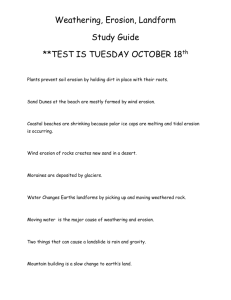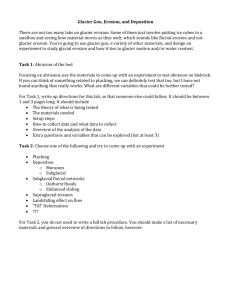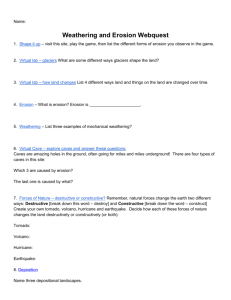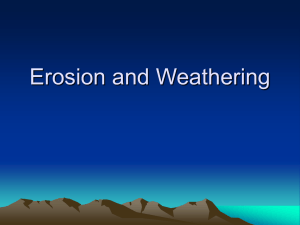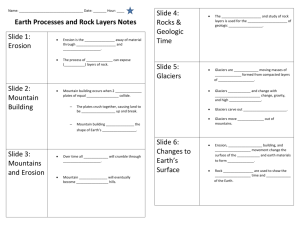Groundwater Erosion
advertisement
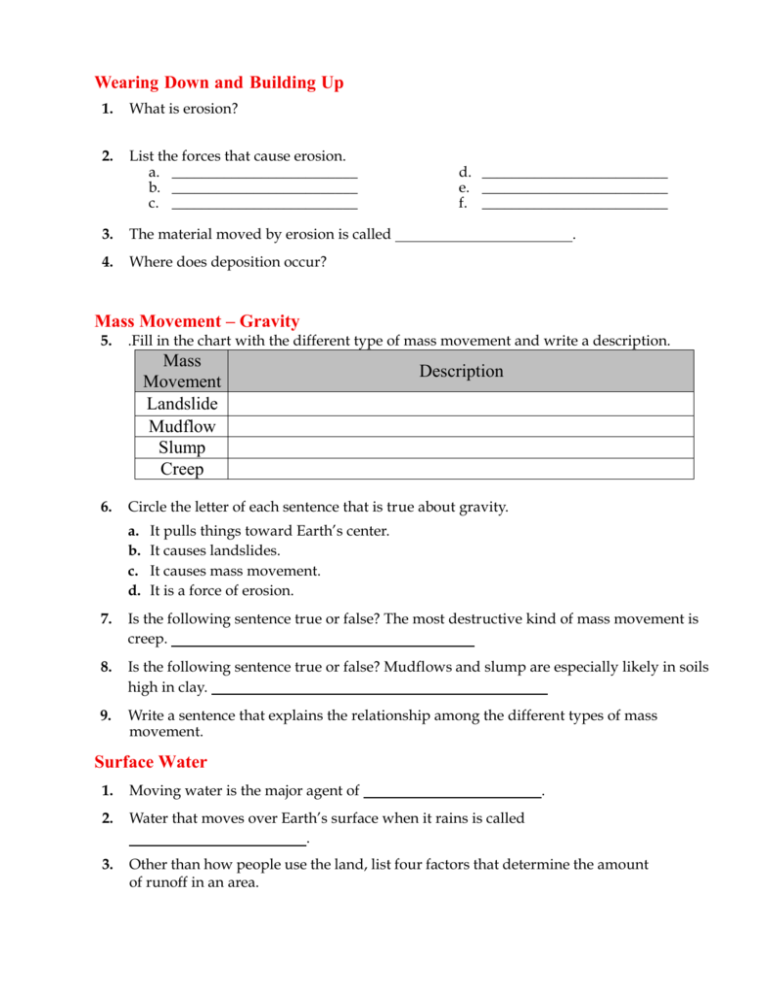
Wearing Down and Building Up 1. What is erosion? 2. List the forces that cause erosion. a. _________________________ b. _________________________ c. _________________________ 3. The material moved by erosion is called 4. Where does deposition occur? d. _________________________ e. _________________________ f. _________________________ . Mass Movement – Gravity 5. .Fill in the chart with the different type of mass movement and write a description. Mass Movement Landslide Mudflow Slump Creep 6. Description Circle the letter of each sentence that is true about gravity. It pulls things toward Earth’s center. It causes landslides. It causes mass movement. It is a force of erosion. 7. Is the following sentence true or false? The most destructive kind of mass movement is creep. 8. Is the following sentence true or false? Mudflows and slump are especially likely in soils high in clay. 9. Write a sentence that explains the relationship among the different types of mass movement. Surface Water 1. Moving water is the major agent of . 2. Water that moves over Earth’s surface when it rains is called . 3. Other than how people use the land, list four factors that determine the amount of runoff in an area. Erosion and Deposition a. b. c. d. 4. Is the following sentence true or false? More runoff generally means less erosion. 5. Fill in the first column of the table with the correct form of moving water. Forms of Moving Water Form Description Water moving in a tiny groove in soil after a rainstorm Water moving in a channel after a rainstorm Water continually flowing down a slope through its own channel Water flowing downhill in a large channel Which form of moving water causes the greatest changes in the shape of the land? Explain. 6. A stream that flows into a larger stream is called a(n)_________________________________. 7. The area of land from which a river and its tributaries collect water is the _______________. 8. How do V-shaped valleys form? 9. When does a river develop meanders? 10. A meander that has been cut off from a river is called a(n) ____________________________ 11. Identify and label each of the following landforms in the illustration: waterfall, oxbow lake, meander, flood plain, and V-shaped valley. Erosion and Deposition c. d. a. e. b. 12. List two landforms created from deposits by rivers. Groundwater Erosion 1. Underground water is called . 2. Is the following sentence true or false? Unlike moving surface water, groundwater does not cause erosion. 3. How does groundwater cause chemical weathering of limestone? 4. Complete the compare/contrast table. Groundwater Deposits in Limestone Caves Type of Deposit Where It Forms How It Forms a. Roof of cave c. b. Floor of cave d. e. How are the deposits similar? f. How are the deposits different? 5. Is the following sentence true or false? An area where sinkholes are common is said to have karst topography. 6. Precipitation that soaks into the ground trickles downward due to ______________. 7. Match the term with its definition in the table below. Term Definition 1. pore a. Allows water to pass through 2. permeable b. Area that is totally filled with water 3. impermeable c. Space between rock and soil particles 4. saturated zone 5. water table 6. unsaturated zone d. Does not let water pass through e. Layer above the water table f. Top of the saturated zone Glaciers 1. Any large mass of ice that moves slowly over land is a(n) _____________________. 2. Circle the letter of each sentence that is true about continental glaciers. a. b. c. d. 3. Circle the letter of each sentence that is true about valley glaciers. a. b. c. d. 4. They are larger than valley glaciers. They spread out over wide areas. They are found only in Antarctica. They cover 2 percent of Earth’s land. They are generally long, narrow glaciers. They are found on many high mountains. They are larger than continental glaciers. They usually move down valleys. Complete the table to show how the different types of glaciers move. Type of Glacier How Glaciers Move How it Moves Flows in all directions Flows in a surge 5. List two processes by which glaciers erode the land. 6. Describe abrasion and how it affects bedrock. 7. When does a glacier deposit the sediment it is carrying? 8. Match each type of glacial landform with its description. Type of Landform 1. till 2. moraine 3. terminal moraine 4. drumlin 5. kettle 6. cirque 7. arête 8. fiord Description a. Small depression formed by a chunk of ice when it melts b. Mixture of sediments a glacier deposits on the surface c. Ridge formed at the edge of a glacier d. Long mound of till that is smoothed in the direction of the glacier ’s flow e. Ridge at the farthest point reached by a glacier f. Sharp ridge separating two cirques g. Bowl-shaped hollow eroded by a glacier h. Sea-filled valley cut by a glacier in a coastal region Waves 1. The movement of energy through a body of water is a(n) 2. 3. . How do most waves form? Circle the letter of each sentence that is true about a wave approaching land. a. b. c. d. It begins to drag on the bottom. It encounters more friction. It speeds up. It moves the water toward the land. 4. List two ways that waves erode land. 5. List three landforms created by wave erosion. 6. An area of wave-washed sediment along a coast is a(n) 7. The process in which beach sediment is moved down the beach with the current is called . 8. Circle the letter of each choice that determines the size of a wave. a. b. c. d. Strength of the wind How long the wind blows How far the wind blows Amount of water the wave carries 9. Circle the letter of the sentence that describes what happens to water particles near the surface when a wave passes by. a. b. c. d. The water particles move toward shore. The water particles move in circles. The water particles move randomly. The water particles move little if at all. 10. Circle the letter of the sentence that describes what happens to water particles in deep water when a wave passes by. a. b. c. d. The water particles move away from shore. The water particles move in large circles. The water particles move randomly. The water particles move little if at all. 11. Match the term with its description. Term 17. longshore drift 18. sandbar 19. rip current Description a. Underwater ridge of sand b. Movement of sand along a beach c. Rapid rush of water out to sea . 12. How do waves shape a beach? 13. A wall of rocks or concrete built outward from a beach to stop longshore drift is called a(n) . 14. Hills of wind-blown sand covered with plants are called________________________. Wind 1. A deposit of wind-blown sand is a(n) 2. Is the following sentence true or false? Wind is the strongest agent of erosion. 3. Why is wind effective in causing erosion in deserts? 4. Circle the letter of each sentence that is true about deflation. a. b. c. d. 5. . It is the main way wind causes erosion. It usually has a great effect on the land. It can create blowouts. It can create desert pavement. Circle the letter of each sentence that is true about abrasion by wind-carried sand. a. b. c. d. It can polish rock. It causes little erosion. It causes most desert landforms. It causes most erosion. 6. Is the following sentence true or false? All the sediment picked up by wind eventually falls to the ground. 7. When does wind-carried sediment fall to the ground? 8. List two types of deposits formed by wind erosion and deposition. 9. Describe the difference between the formation of sand dunes and the formation of loess.

